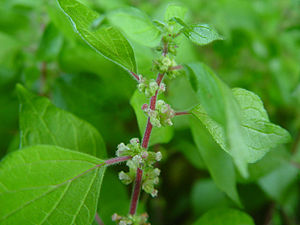Glass herbs
| Glass herbs | ||||||||||||
|---|---|---|---|---|---|---|---|---|---|---|---|---|

Spreading glass herb ( Parietaria judaica ) |
||||||||||||
| Systematics | ||||||||||||
|
||||||||||||
| Scientific name | ||||||||||||
| Parietaria | ||||||||||||
| L. |
The glass herbs ( Parietaria ) are a plant species from the family of the nettle plants (Urticaceae).
features
They are annual or perennial herbaceous plants that grow upright or ascending. As a rule, they reach heights of growth between 20 and 50 cm.
In contrast to most of the other species in the family, the leaves are alternate on the stem and have a smooth leaf margin. There are no stinging hairs in the glass herbs. Their leaves and stems are only covered with short hair. Stipules they have not. The shape of the leaves is mostly egg-shaped or rhombic; however, their size varies greatly from species to species.
The inconspicuous green or reddish-green flowers are in clusters or short coils in the leaf axils. The bracts within these clusters resemble the sepals . There are both hermaphrodite and separate-sex flowers in the genus. The stamens of the male flowers are curved into the flower, but this can suddenly throw the anthers outwards.
Egg-shaped achenes are formed as fruits .
distribution
The genus occurs in the temperate to subtropical areas of the northern hemisphere .
Most of the species grow in more or less fresh, somewhat shady ruderal spots . Several species are often found in old walls.
Etymology and common names
The scientific name Parietaria comes from the Latin "paries" (= wall), "parietarius" (= from the wall). It refers to the preferred place of growth of some European species, especially the glass herb ( Parietaria judaica ).
The German name "glass herb" comes from the fact that the ashes of these plants were used to clean glass in the past.
As the common name (herba) parietaria also are wall herb , wall herb and Rebhühnerkraut occupied.
An old German name for glass herb was also day and night .
The other common name of St. Peter's herb (partly synonymous with “day and night”) is common to Parietaria species and plants from other genera.
species
In Central Europe three species of glassweed occur wild:
- Spreading glass herb ( Parietaria judaica L. )
- Upright glass herb ( Parietaria officinalis L. )
- Pennsylvanian glass herb ( Parietaria pensylvanica Muhl. Ex Willd. )
In total, the genus consists of 20 to 30 species. There are a number of synonyms for some species that are equally in use. Not all synonyms are resolved in the following list, which is why it contains several types more than once. (List of species according to)
) |
|
swell
literature
- David E. Boufford: Parietaria. In: Flora of North America Editorial Committee (Ed.): Flora of North America North of Mexico . Volume 3: Magnoliophyta: Magnoliidae and Hamamelidae . Oxford University Press, New York / Oxford a. a. 1997, ISBN 0-19-511246-6 , pp. 406 (English). , online.
- Chen Jiarui, Ib Friis, C. Melanie Wilmot-Dear: Parietaria. In: Wu Zhengyi, Peter H. Raven, Deyuan Hong (Eds.): Flora of China . Volume 5: Ulmaceae through Basellaceae . Science Press / Missouri Botanical Garden Press, Beijing / St. Louis 2003, ISBN 1-930723-27-X , pp. 189 (English). , online.
- Heinrich Marzell : Dictionary of German plant names. (with the assistance of Wilhelm Wissmann and Wolfgang Pfeifer ): Volume I – V, Leipzig, Stuttgart and Wiesbaden 1943–1979, Volume III (from column 481) and IV ed. by Heinz Paul, Volume V (register volume) 1958 with Wilhelm Wissmann; New print Cologne 2000. ISBN 3-88059-982-3 ; Volume III, pp. 571-574.
Individual evidence
- ^ De simplici medicina. Herbal manuscript from the 14th century. Edited from the original in the possession of the Basel University Library as a facsimile with accompanying text. by Arnold Pfister, (Sandoz AG) Basel 1960; 2nd edition, ibid. 1961, sheet 24 v .
- ↑ Heinrich Marzell : Dictionary of German plant names. (with the assistance of Wilhelm Wissmann and Wolfgang Pfeifer ): Volume I – V, Leipzig, Stuttgart and Wiesbaden 1943–1979, Volume III (from column 481) and IV ed. by Heinz Paul, Volume V (register volume) 1958 with Wilhelm Wissmann; New print Cologne 2000. ISBN 3-88059-982-3 ; Volume III, p. 573.
- ↑ Robert Damme: The Stralsund vocabulary. Edition and investigation of a Middle Low German-Latin vocabulary manuscript from the 15th century. Cologne / Vienna 1989 (= Low German Studies. Volume 34), pp. 178 and 180.
- ↑ Pedacii Dioscoridis Anazarbaei herb book [...]. Translated into German by Johannes Danzius, Frankfurt am Main (Petrus Uffenbach) 1610; Reprint Grünwald near Munich 1964, p. 292 f.
- ↑ Brigitte Hoppe : Hieronymus Bock's book of herbs. Scientific historical investigation, with a list of all plants in the work, the literary sources of the medicinal indications and the uses of the plants. Hiersemann, Stuttgart 1969, p. 148 f.
- ↑ Plantamed
- ↑ a b c d e f g h i j k l m n o Pertti Uotila: Urticaceae. Parietaria In: Euro + Med Plantbase - the information resource for Euro-Mediterranean plant diversity. Berlin 2011